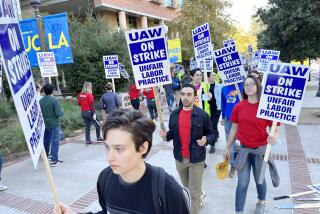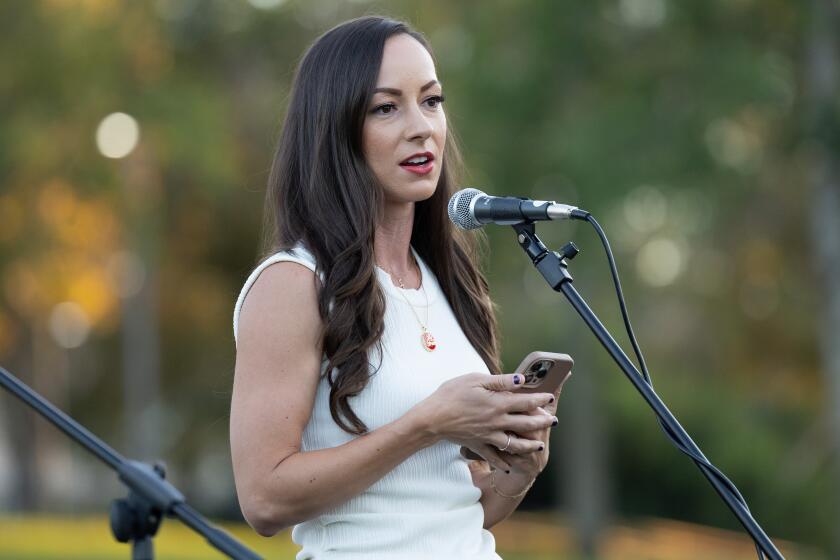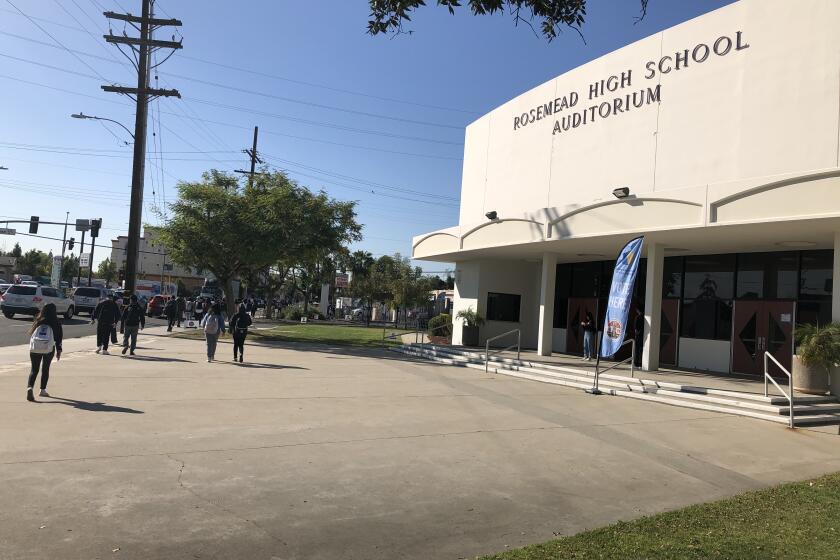New Preschool Rich in Opportunity
It takes less than a minute for Noemi Jimenez to get to work each morning, even driving slowly on the narrow streets that lead from her modest home in Cabrillo Village to a model preschool designed to pave the way for children at the former farm labor camp.
But the trip covers more ground than that.
The daughter of immigrant farm workers, Jimenez, 32, was born and raised just a few blocks from the new school in the east Ventura community, where the residents are mostly poor and academic opportunities have been in short supply.
Now she is part of a movement to bring early education to Cabrillo Village youngsters, opening a world of numbers and letters unavailable when she grew up.
“This school has really brought a lot of benefits to this community,” Jimenez said. She is one of two full-time teachers--both raised in Cabrillo Village--at the preschool launched two years ago by Ventura Unified School District.
“It’s a jump-start for the children here,” she said. “And I strongly feel that parents really appreciate the opportunities we are providing for their children.”
Tapping into a nationwide push to deliver early education to as many children as possible, the Ventura district has created six state-funded preschools since 1992, with two more scheduled to open this school year.
The free preschools are available to parents of children between ages 3 and 5 who meet income eligibility requirements.
The one at Cabrillo Village is the first in the district operating away from a school campus. Instead, it is located in the heart of the tightknit but isolated cooperative housing project founded 25 years ago by farm laborers seeking their own slice of suburban life.
School district Supt. Trudy Arriaga said the Cabrillo Village preschool has also drawn parents from outside the area, who have seen for themselves that the Latino enclave is not the dangerous place some people have made it out to be.
But most importantly, Arriaga said, the program has served to level the playing field between children in the working-class community and those from wealthier neighborhoods, where private preschool is affordable and educational opportunities abound.
“It just made so much sense to put a preschool in that neighborhood,” said Arriaga, who created the district’s first preschool while she was the principal at Sheridan Way Elementary School.
With 350 preschool students enrolled districtwide, Arriaga said her goal is to make the program available on all elementary school campuses.
School Readiness Can Lead to Success
“The research is showing that school readiness is the No. 1 factor in student success,” she said. “And the good news for us is that that is something we have total and complete control over.”
At the moment, with 15 hungry and energetic 3-year-olds to look after, Jimenez and teaching partner Norma Garcia are doing an admirable job of maintaining control.
It’s snack time at the Cabrillo Village preschool, and the rush is on to find a tiny seat at the tiny tables where a feast of sandwiches, peanut butter and trail mix is being laid out. The snacks are trucked in daily from the district kitchen, to ensure the pupils are eating the same thing as every other preschooler.
There are lessons to be learned at every corner in this classroom. Even when the youngsters finish their snack, a few stay behind to wipe down tables.
“When they go to kindergarten, they’ll know how to clean and pick up after themselves,” said community volunteer Maria Meza, a 25-year Cabrillo Village resident who helps out in the classroom daily because she thinks it’s a good cause.
After snack time, Garcia, director of the preschool and teacher for the morning session, has the fidgety youngsters sit cross-legged on the rug and put on their thinking caps, directly under a collection of Sesame Street and Disney records, which dangle from the ceiling on red string.
Immediately, the children tap their temples. The time has come for hard decisions: Play-doh or Mr. Potato Head? The clay commands a loyal following, as most youngsters embark on a mission to turn the carrot-colored substance into cartoon characters and string cheese.
The preschool has 30 students, divided between a morning and afternoon session.
Loretta Galaviz, who is in charge of child development programs for the Ventura district, said it costs about $150,000 a year to run the program. But studies have shown that for every $1 invested in quality preschool programs, taxpayers save $7 in expenditures for remedial programs and other rehabilitative services.
The partnership with Cabrillo Village has been particularly gratifying, because board members of the cooperative housing project donated space and provided play equipment and other amenities, Galaviz said.
“It was important for us to reach out and let people in the community know they were valued,” she said. “And they have gone out of their way to make us part of their community.”
Many Cabrillo Village parents see it as an even trade.
Agustin and Irma Avina have seen their daughter, Elizabeth, 4, make great strides since enrolling in the preschool last year. In her first year, she learned to count and write her name.
“It gets the idea planted in their head about going on to kindergarten,” said Agustin Avina, a disabled strawberry picker who has lived in the community for six years. “Most people who live here are of poor resources, so it is good for all of us.”
Estela Martinez, who lives near the Ventura County Government Center, drives her son, Roberto, to the program every day and is another classroom volunteer.
She said she likes the fact that a good deal of the instruction is in Spanish--the main bulletin board, for example, tells students that the color of the month is orange or anaranjado--because it provides a bilingual boost to her mostly English-speaking son.
“He’s like a little sponge; he absorbs everything,” Martinez said. “I come here to help out and to show him I’m just as involved as he is in his education.”
Garcia said one of the greater benefits to the community is that the teachers know exactly how to prepare the children for kindergarten. She is proud that most of last year’s 4-year-olds were strong enough academically to make it into a kindergarten-first grade combination class at Juanamaria Elementary School this year.
But she is equally proud to be part of a program that extends quality early childhood education to low-income families that need it most.
“I think everyone is starting to see the results,” said Garcia, a former Cabrillo Village resident, who started teaching preschool in the district in 1996.
“I feel very proud when I see friends I grew up with coming to turn their children over to me,” she said. “It tells me that they trust me and they know I’ll take care of their children.”
Educators Push for Preschool Programs
California’s top educators call the need for quality preschool programs one of the state’s most urgent priorities.
According to research children--especially those from low-income families--who attend preschool enter kindergarten better prepared to learn. They develop higher IQs and are more likely to attend college. And they are less likely to drop out, get pregnant as teens or wind up on welfare.
Experts say such programs are critical in helping to close the educational attainment gap between students from poor communities and those who are more affluent.
“Very clearly, this is the best investment, dollar-for-dollar, that a school district can make,” said Ventura County Supt. of Schools Charles Weis, who co-chaired a state task force that called for offering preschool programs to all of California’s 3- and 4-year-olds. The estimated annual cost of such an endeavor is $5 billion.
“This is not a radical idea; it has been well researched and well thought out,” Weis said. “And I really commend Ventura for doing it. They don’t have any more money than anyone else, but they’ve really seen the value of it and I think the return will be well worth it.”
At Cabrillo Village, educators are not doing it alone. Members of the community have pitched in to make it happen, donating time and muscle to transform a former meeting room into a state-of-the-art learning center.
Lonnie Miramontes, who manages the housing cooperative, said community leaders are preparing to launch after-school programs to complement the new preschool, offering tutoring and other services to students of all grade levels.
The families at Cabrillo Village may not have as much money as those in other parts of town, Miramontes said, but the community remains the kind of place where neighbors know each other and where residents band together to make life better.
“We know it’s an important program, and I’m sure the school district appreciates being here,” he said. “It obviously benefits our children, but we expect it to be around long enough to benefit the children of generations to come.”
More to Read
Start your day right
Sign up for Essential California for news, features and recommendations from the L.A. Times and beyond in your inbox six days a week.
You may occasionally receive promotional content from the Los Angeles Times.






